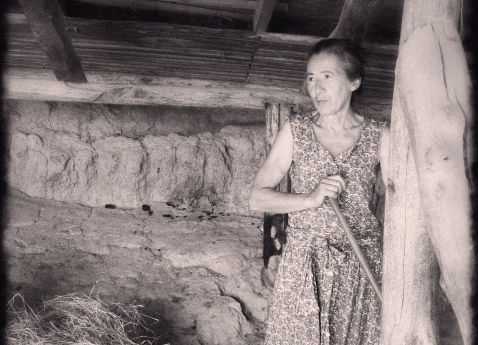by Lindsay Vietor
Close your eyes. Imagine Max from Where the Wild Things Are. Now imagine that instead of a little boy, he is a beautifully ragged Hungarian woman, with a long gray braid, dressed comfortably in a flowered sheath, thick wool socks, and blue suede sneakers. An outfit you could almost expect to see on an ironic hipster, cat-walking down Bedford Avenue in Brooklyn. There she is, swinging on trees and howling with the beasts. Only the beasts aren’t the Wild Things, they are a herd of goats, a lame deer named Bergamot, and an enormous but very shy horse. And she never goes back to the real world like Max. She stays. This is her home and these animals are her family. We call her The Goat Lady.
We are in the Tokay region of Hungary, a little farther north of the vineyards that draw most foreign visitors. It is an intense Indian summer and the grasses along the endless stretch of road are slightly singed from the brutal heat. As we slowly wind up into the cooler hillside, under the speckled shadows of the trees, her farm comes into view.
She greets us with a warm smile and mischievous eyes, perhaps a little jarred to see so many people at her place. She takes us out in the field to meet the goats who are with their tender, a mentally disabled Roma man. He has worked for her close to seven years. The two seldom talk but she expresses to us her comfort in seeing him morning after morning.

Afterward, we head back to the stable, goats in tow, and meet them more personally. They all have their own names. She helps remember who is who by using the same first letter for all goats born in a season.
The reason for our visit was to taste her goat cheese. It is not a traditional product in Hungary, where, as one resident commented, cheese is, “either round, white and tasteless or the processed stuff.” This makes her one of the few artisanal producers and perhaps the sole one in the region. The only reason she even has goats is because, years ago, some man who could not pay a debt, dropped a few off with her brother as a settlement. Her brother didn’t last on the farm. He left, and she stayed behind with her growing goat family. She is remarkably tender and caring with them. She’s spent many nights asleep outside in the stable with the herd, especially when new young goats arrive in colder seasons, and she fears they will freeze at night. She slept with Bergamot the deer as well, when she found him as a foal, wounded in a field. He stayed in her bed until he was well enough, and now, despite being back in the wild, he swings by the farm everyday for lunch.
After a quick milking demonstration, she brings us around to the back of the house. We sit down on wobbly benches, green and damp with age. Behind us is the well, her only water source. She pops into the house and returns with a tin tray scattered with a bunch of sticky muscat grapes, picked from a neighboring vineyard, green peppers the size of a baby’s fist, fresh mint, and some walnuts. Everything but the grapes comes from her own plot of land. Wadded up in plastic wrap among the accoutrements is some of her goat cheese.
She made it three days ago for herself. In fact, most of the cheese The Goat Lady makes, she eats. The little that remains is aged into half dollar size rounds that dry up to the point of seeming petrified, and are then sold to eager chefs in Budapest who keep encouraging her to make more. She begins spreading the cheese on bits of green pepper and passes them around. A far cry from the cylindrical logs of goat cheese that languish in the vacuum-packed graveyard at the supermarket; her cheese, like her goats, gains its strength from its ability to breath.
Quickly running out of pepper, she realizes she has no other vehicle on which to serve the cheese. “Hold out your fists,” she says and spreads the cool cheese onto the back of our hands. Marta, our Hungarian guide (and mother to one of our companions) then composes the “dish,” adding little garnishes of grapes, walnuts and fresh mint to the snow white smear.
Like giddy puppies, we stick out our tongues and furiously lick the back of our hands, tasting the happy balance of the sweet aromatic grapes, the tingling bite of mint, the buttery walnut crunch and the fresh grassy cheese. A chef couldn’t have plated it better. We do it again and again until we run out of walnuts and Marta has to start banging the walnut tree looming above us with a long wooden pole. She whacks it with fervor, and the nuts hail down onto the table. The Goat Lady unwraps another bundle of cheese and we start the ritual again.
Lindsay Vietor is a Masters student at the University of Gastronomic Sciences.

